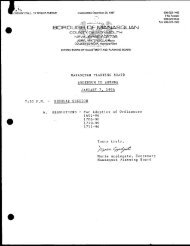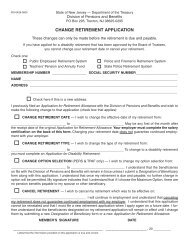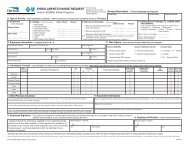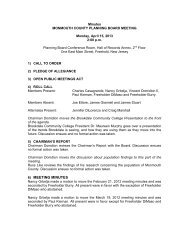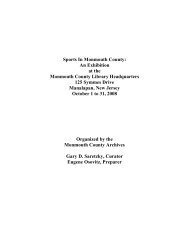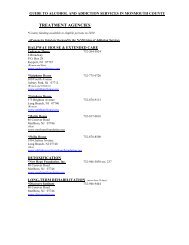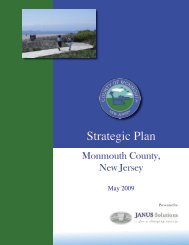NATURAL and CULTURAL FEATURES of MONMOUTH COUNTY
NATURAL and CULTURAL FEATURES of MONMOUTH COUNTY
NATURAL and CULTURAL FEATURES of MONMOUTH COUNTY
Create successful ePaper yourself
Turn your PDF publications into a flip-book with our unique Google optimized e-Paper software.
s<strong>and</strong> 1.5 miles <strong>of</strong>fshore; beaches were planned to be replaced every 6 years until 2044 (Bates,<br />
2006; Farrell, 2007). In 2006, the project won a national award from the American Shore <strong>and</strong><br />
Beach Preservation Association (Bates, 2006). S<strong>and</strong>y Hook Cove, Monmouth Beach <strong>and</strong><br />
southern Long Branch are the only beaches needing renourishment as <strong>of</strong> 2007 (Farrell, 2007). NJ<br />
spends the highest amount <strong>of</strong> dollars per mile <strong>of</strong> coastline on beach replenishment than any other<br />
state, including California <strong>and</strong> Florida (Farrell, 2007).<br />
Currents<br />
Sediment transport is almost entirely driven by wave action. The littoral, wind-driven current<br />
flows to the north in Monmouth County, depositing s<strong>and</strong> on the south side <strong>of</strong> jetties (the “updrift<br />
side”) during the summer (ACE, 1974; Herrington, 2005; USDI, 2004). In addition, net s<strong>and</strong><br />
movement along the coast reverses direction around a dynamic nodal point between the<br />
Manasquan Inlet <strong>and</strong> Ortley Beach, due to the location <strong>of</strong> Long Isl<strong>and</strong>, NY. Because Long Isl<strong>and</strong><br />
shelters the Monmouth County coast from large winter waves generated by Nor'easters, a greater<br />
proportion <strong>of</strong> wave energy from the southeast dominates the Monmouth county shoreline,<br />
leaving more s<strong>and</strong> on the south side <strong>of</strong> jetties (ACE, 1974; Herrington, 2005; RSCNJCRC, 2006;<br />
USDI, 2004). The opposite happens south <strong>of</strong> the Barnegat Inlet; because Nor’easter waves reach<br />
this part <strong>of</strong> the coast unimpeded, net littoral drift deposits more s<strong>and</strong> on the north side <strong>of</strong> jetties.<br />
(ACE, 1974; Herrington, 2005; USDI, 2004). It is estimated that 382,000 cubic meters <strong>of</strong><br />
longshore s<strong>and</strong> pass from Manasquan through S<strong>and</strong>y Hook every year, while 38,000 cubic<br />
meters pass from Manasquan to the Barnegat Inlet (Terwilliger, 2004; USDI, 2004).<br />
In addition to littoral drift, there is a second ocean current that is driven by the Hudson-Raritan<br />
plume, which carries floatables from the metropolitan area after rainfall. The Hudson-Raritan<br />
plume generally flows south <strong>and</strong> l<strong>and</strong>falls between Monmouth Beach <strong>and</strong> Long Branch. Local<br />
circulation patterns can run counter to this southerly current <strong>and</strong> cause it to slow down <strong>and</strong><br />
reverse direction, altering the biological <strong>and</strong> chemical conditions <strong>of</strong> the water, <strong>and</strong> trapping<br />
floatables, which will then drift with onshore winds onto beaches. For example, the area around<br />
the discharges <strong>of</strong> the Manasquan River <strong>and</strong> Barnegat Inlet have small nodes <strong>of</strong> current<br />
bifurcation, where fresh water discharges can actually flow north against the prevailing southerly<br />
current <strong>of</strong> the ocean (Ashely et. al., 1986). These are also areas where floatables from the<br />
Hudson–Raritan plume have historically washed up following heavy rains <strong>and</strong> strong onshore<br />
winds. The NJDEP has reported that their “Clean Shores” program has removed 110 million<br />
pounds <strong>of</strong> floatable debris from the NJ coastline from 1989 through 2005, <strong>and</strong> now average<br />
removing about 5 million pounds from 100 miles <strong>of</strong> beach annually (Harrington, 2006). When<br />
seaweed or trash float on the water in a relatively straight line, it indicates that a tideline has<br />
formed (Ross, 2000). Tidelines occur when different types <strong>of</strong> waters meet, <strong>and</strong> commonly form<br />
outside estuaries <strong>and</strong> inlets. Differences in salinity will cause freshwater to ride over the denser<br />
sea water, <strong>and</strong> debris will be skimmed into these lines; differences in the tidal currents will also<br />
cause a tideline to set up (Ross, 2000).<br />
Jetty Rips<br />
The strong, infrequent rip currents that are associated with beach closures <strong>and</strong> drownings occur<br />
near s<strong>and</strong>bars, jetties <strong>and</strong> piers, when longshore currents are strongest, waves are high, <strong>and</strong> the<br />
wind is blowing onshore during falling tides, when more water is draining seaward (Ross, 2004).<br />
Smaller rips regularly form over the high spots/small s<strong>and</strong>bars that build up on the shallower,<br />
southeast side <strong>of</strong> jetties (groins) in Monmouth County, where southerly winds drive the




